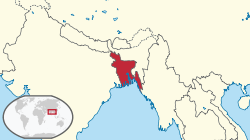
Back Бангладеш Abkhazian Bangladèsh ACE Бангладеш ADY Bangladesj Afrikaans Bangladesch ALS ባንግላዴሽ Amharic Bangladesh AMI Bangladesh AN Bængladesc ANG बांग्लादेश ANP
People's Republic of Bangladesh
| |
|---|---|
| Motto: Nationalism, secularism, socialism, and democracy | |
| Anthem: Amar Shonar Bangla My Golden Bengal | |
 | |
| Capital and largest city | Dhaka 23°42′N 90°21′E / 23.700°N 90.350°E |
| Official languages | Bengali |
| Common languages | Bengali (state language), English |
| Ethnic groups (1998) | 98% Bengali 2% other[1] |
| Religion | Islam |
| Demonym(s) | Bangladeshi |
| Government | Unitary parliamentary republic[2] |
| Mohammed Shahabuddin[3] | |
| Muhammad Yunus | |
• Speaker | Vacant |
| Syed Mahmud Hossain | |
| Legislature | Jatiya Sangsad |
| Independence from Pakistan | |
• Declared | 26 March 1971 |
• Current constitution | 4 November 1972[1] |
| Area | |
• Total | 148,460 km2 (57,320 sq mi) (93th) |
• Water (%) | 6.4 |
| Population | |
• 2018 estimate | 166,368,149a (8th) |
• Density | 964.42/km2 (2,497.8/sq mi) (9th a) |
| GDP (PPP) | 2018 estimate |
• Total | $758 billion (29th)[4] |
• Per capita | $4,600[4] |
| GDP (nominal) | 2018 estimate |
• Total | $284.2 billion[4] |
• Per capita | $1,740[4] |
| Gini (2005) | 33.2[5] medium |
| HDI (2018) | medium · 136th |
| Currency | Taka (BDT) |
| Time zone | UTC+6 (BST) |
| Driving side | left |
| Calling code | +880 |
| ISO 3166 code | BD |
| Internet TLD | .bd |
Website Official website | |
| |
Bangladesh (officially called People's Republic of Bangladesh) is a country in South Asia. To its west is West Bengal of India. To its east and northeast is Northeast India and to its southeast is Myanmar. Bangladesh's capital and largest city is Dhaka (formerly "Dacca"). Countries that are near Bangladesh include the People's Republic of China, Bhutan, and Nepal. To the south of Bangladesh is the Bay of Bengal.
Bangladesh got its independence from Pakistan in 1971. This was after a war in which over a million people died. The official religion of Bangladesh is Islam and most Bangladeshi people are Muslim.[7] Bangladesh has an area of 57,320 mi² or (142,576 km²). It is slightly smaller than Tajikistan. It ranks 92 out of 195 sovereign countries by area. There are two main rivers in Bangladesh: The Ganges and the Brahmaputra River (called Padma and Jamuna in Bangladesh). They are among the most important sources of economy, also they are sacred to Hindu people. There are often floods in Bangladesh because of these two rivers.
Bangladesh has a population of 174.3 million as per 2021 census official survey.[8][9]
In 5th August 2024, the Awami League regime fell after a student-led mass uprising (July Revolution, Gen-Z Revolution) took place. The former prime minister, Sheikh Hasina, fled to India after the revolution.
- ↑ 1.0 1.1 Central Intelligence Agency (2011). "Bangladesh". The World Factbook. Langley, Virginia: Central Intelligence Agency. Archived from the original on 1 January 2021. Retrieved 5 October 2011.
- ↑ Constitution of Bangladesh Archived 2012-03-06 at the Wayback Machine, Part V, Chapter 1, Article 66; University of Minnesota, retrieved: 28 August 2010
- ↑ "Life Sketch of Mr. Md. Abdul Hamid". Office of the President of Bangladesh. Archived from the original on 13 March 2016. Retrieved 30 October 2016.
- ↑ 4.0 4.1 4.2 4.3 "Bangladesh". International Monetary Fund. Retrieved 20 April 2011.
- ↑ "Distribution of family income – Gini index". The World Factbook. CIA. Archived from the original on 13 June 2007. Retrieved 1 September 2009.
- ↑ "Human Development Report 2018. Human development index trends: Table G" (PDF). The United Nations. January 2010. Archived from the original (PDF) on 5 December 2010. Retrieved 14 July 2018.
- ↑ "Religion in Bangladesh". Studycountry. Retrieved 2019-01-04.
- ↑ Cite error: The named reference
:0was used but no text was provided for refs named (see the help page). - ↑
{{cite journal}}: Empty citation (help)

